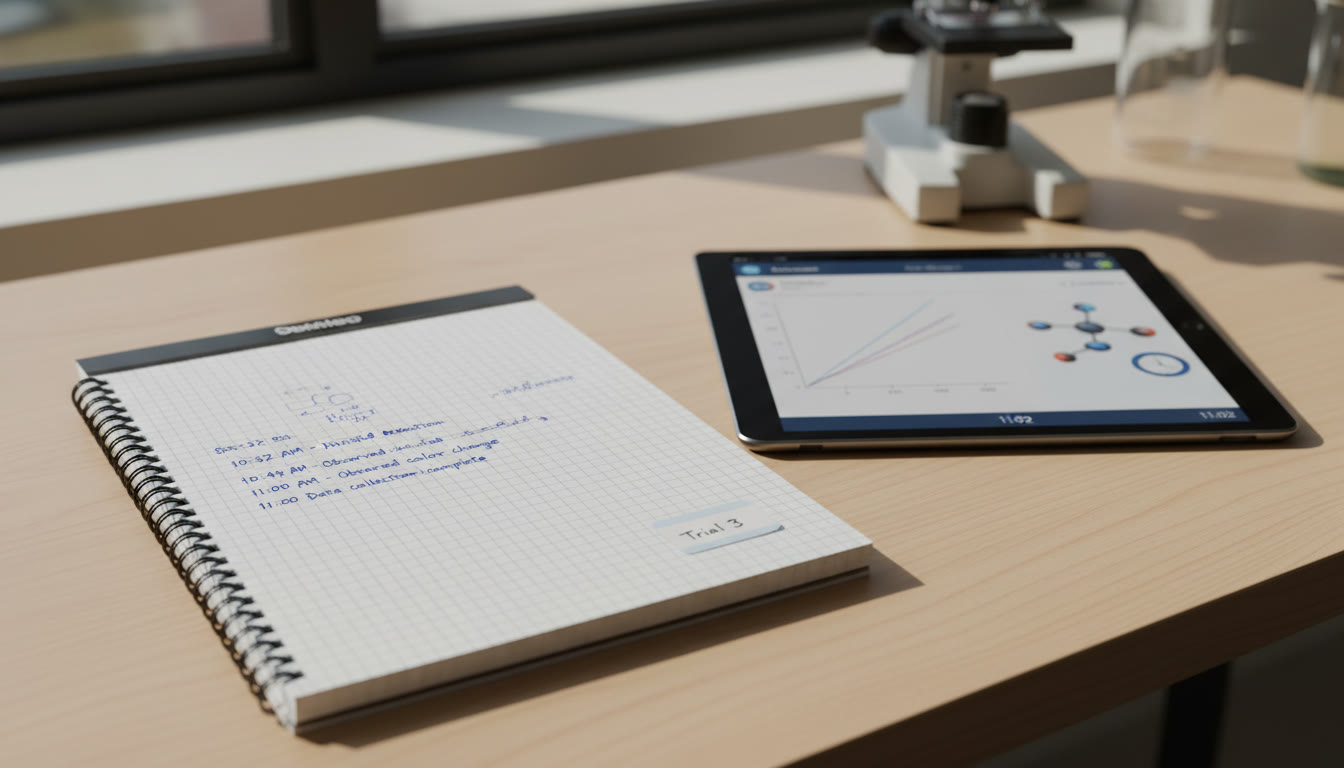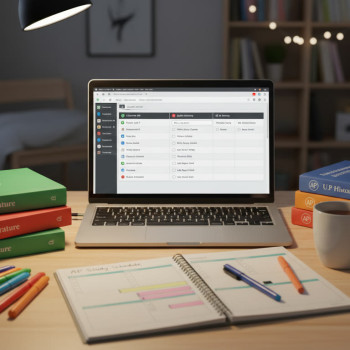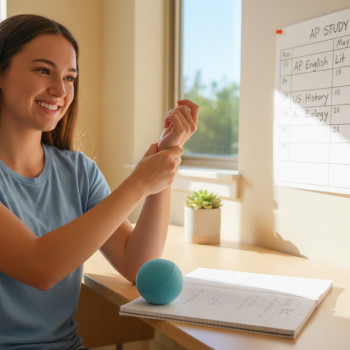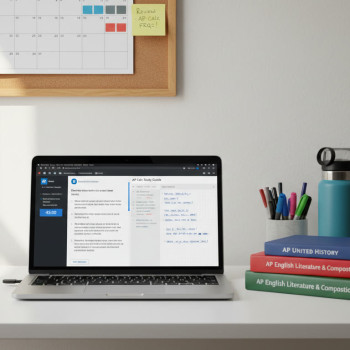When the Lab Door Won’t Open: An Honest Introduction
It’s a scene many students and parents recognize: the school’s science lab is booked solid, safety rules are strict, or facility access has been limited by schedules, renovations, or policy. For Advanced Placement (AP) science students—Biology, Chemistry, Physics, Environmental Science, and others—laboratory experience is more than a checklist item. It’s a core way to develop experimental reasoning, data literacy, and the kind of evidence AP readers expect when assessing coursework or portfolio-style submissions.
But what happens when hands-on lab time is rigidly constrained? The short answer: you build credible, well-documented virtual and alternative evidence that demonstrates the same learning objectives. This blog is a practical, student-and-parent-oriented roadmap for producing robust, defensible lab evidence that aligns with AP expectations. We’ll walk through principles, real-world examples, a sample data table, grading-aligned rubrics, and study-planning tips (including how Sparkl’s personalized tutoring can help you design and polish alternative lab work).
Why Alternative or Virtual Evidence Can Be Valid—and When It Isn’t
First, let’s be clear: AP scorers and college admissions professionals value authentic inquiry and clear scientific reasoning, not just whether a particular apparatus was used. Virtual experiments, simulations, field observations, and thoughtfully designed demonstrations can all show mastery—IF they are documented, replicable, and tied to the learning goals.
- Valid when: The activity targets the same inquiry practices (hypothesis formation, data collection, analysis, uncertainty estimation, and conclusions) and includes detailed methods, raw data, and error analysis.
- Weak or invalid when: Data are missing, methods are vague, outcomes are simply reported without reflection, or results appear fabricated or copied.
That’s the key: documentation and transparency. If you can show how you arrived at your results and what they mean, you can build evidence that stands up to rigorous evaluation.

Types of Alternative Lab Evidence You Can Use
There is no one-size-fits-all solution. Consider the following accepted and effective alternatives—each with tips on how to make them convincing to an AP reader.
1. High-Quality Simulations and Virtual Labs
Platforms that let students manipulate variables and record quantitative output can be powerful. What matters is that you: (a) treat the simulation as an experimental system, (b) record step-by-step methods, (c) capture raw data and screenshots where appropriate, and (d) perform statistical analysis and error discussion as you would with a physical experiment.
- Tip: Run multiple trials changing one variable at a time. Export or screenshot raw output and include time stamps or unique identifiers.
- Tip: Compare simulated results to expected theoretical values and explain deviations.
2. Field Studies and Environmental Sampling
For Environmental Science or Biology, in-person field observations—soil pH readings in different sites, water turbidity measures, biodiversity transects—can substitute for lab-based experiments. These require careful location documentation, reproducible sampling strategies, and error awareness (e.g., seasonal effects).
- Tip: Use GPS coordinates or detailed maps and date/time stamps for each sample.
- Tip: Photograph sampling setups and raw sample collection to bolster credibility.
3. Household or Classroom Demonstrations with Measured Outcomes
Sometimes a basic setup (timed reactions with safe reagents, pendulum experiments for physics, or enzyme activity using household items) can be done outside a formal lab. The trick is to measure carefully, control variables, and document materials and safety measures.
- Tip: Use a smartphone for slow-motion or time-lapse to gather precise temporal data.
- Tip: Include a materials list with reagent concentrations, volumes, and sourcing details.
4. Data Analysis Projects Using Public Datasets
AP courses emphasize data literacy. Working with large, real-world datasets (climate records, population data, gene expression data, reaction rate tables) can show analytical depth. Describe filtering steps, statistical tests used, and how the dataset addresses a testable question.
- Tip: Include code snippets or spreadsheets and explain each data-cleaning step.
- Tip: Make reproducible notebooks (clearly labeled) so graders can trace your steps.
What AP Readers Expect: The Evidence Checklist
When preparing alternative lab evidence, aim to meet these expectations. Treat this like a checklist you can attach to the front of your submission.
- Clear research/question statement and hypothesis.
- Detailed materials and methods so someone else could replicate the steps.
- Raw data presented clearly (tables, screenshots, code outputs).
- Data analysis with appropriate statistics (mean, standard deviation, graphical analysis, regression when applicable).
- Uncertainty and error discussion—what limits the result and how future work could improve it.
- Connections back to course concepts and relevant theory.
How to Show Authenticity
Authenticity is the single most important trait. Include timestamped photos of your setup or screenshots of simulations, annotated lab notebooks (digital or scanned), teacher or mentor confirmations when possible, and a log of trial runs. If you used household reagents or online tools, note versions, calibration steps, and software metadata.
Example Project Walk-Through: A Virtual Chemistry Kinetics Study
Below is a worked example that demonstrates how to build a complete, AP-ready package using a simulation combined with household validation. Follow this structure and adapt to your course.
Research Question
How does temperature affect the rate of a simulated first-order reaction, and do simulated rate constants match those predicted by the Arrhenius equation?
Materials and Methods
- Simulation platform and version (recorded), sample reaction parameters.
- Procedure: Run simulation at five temperatures (e.g., 280K, 293K, 303K, 313K, 323K); record concentration vs. time at regular intervals; run three trials per temperature.
- Household validation: Simple color-change reaction timed at two temperatures to show trend directionally (documented with videos).
Raw Data (Sample)
| Trial | Temperature (K) | Initial [A] (mol L^-1) | k (s^-1) (from fit) | Mean k (s^-1) | Std Dev |
|---|---|---|---|---|---|
| 1 | 280 | 0.100 | 0.0012 | 0.0013 | 0.0001 |
| 2 | 293 | 0.100 | 0.0020 | 0.0021 | 0.0001 |
| 3 | 303 | 0.100 | 0.0035 | 0.0034 | 0.0002 |
Note: For a real AP submission include full time-series data for each trial and graphs (ln[A] vs. time) with regression statistics. The table above is a condensed example.
Analysis and Interpretation
Convert each fit to an Arrhenius plot (ln k vs. 1/T). Fit a line, extract activation energy (Ea) from the slope, and compare to expected literature values or theoretical predictions. Discuss deviations—are they simulation artifacts? Numerical fitting errors? Measurement uncertainty from household validation?
Uncertainty Discussion
Explain how trial-to-trial variation was quantified (standard deviation and confidence intervals) and where systematic errors might be present (e.g., how the simulation approximates diffusion or neglects side reactions). Propose further validation steps (e.g., using a different simulation engine, or collecting higher-resolution time data).
Rubric for Self-Assessment (Use Before Submission)
Score your work against this rubric to catch weak spots. Aim for “Meets” or “Exceeds” across categories before finalizing.
| Category | Insufficient | Developing | Meets Expectations | Exceeds |
|---|---|---|---|---|
| Question and Hypothesis | Vague or missing | Some clarity, weak link to theory | Clear, testable, theory-linked | Clearly testable, novel, well-motivated |
| Methods and Replicability | Missing steps; not reproducible | Some details but gaps remain | Complete steps and materials | Includes alternative protocols and versioning |
| Data and Analysis | Few data, no analysis | Basic analysis, limited statistics | Appropriate stats, full data shown | Thorough analysis, multiple models compared |
| Uncertainty and Limitations | Ignored | Some mention, superficial | Quantified and discussed | Detailed error propagation and mitigation |
| Connection to Course Concepts | Loose or absent | Basic conceptual links | Clearly tied to curriculum | Integrates advanced concepts and implications |
Documentation Best Practices: Make Your Submission Easy to Read and Verify
AP readers have limited time. Clear, standardized presentation helps your cause. Here are concrete practices:
- Start with a one-page summary: question, conclusions, and main evidence highlights.
- Number experiments/trials consistently and include table-of-contents bookmarks for long documents.
- Use captions for every figure and table describing what each shows and how it was generated.
- Include annotated raw data files: CSVs, screenshots with timestamps, and short video clips when appropriate.
- Ask a teacher to co-sign or verify experimental logs if possible; include their statement as a PDF or scanned note.

Common Pitfalls and How to Avoid Them
- Pitfall: Presenting only final conclusions without raw data. Fix: Attach raw tables and at least one reproduced plot per trial.
- Pitfall: Vague methods like “we measured pH.” Fix: State instrument model, calibration steps, measurement intervals, and how replicates were performed.
- Pitfall: Overstating claims. Fix: Use cautious language—”suggests,” “consistent with,” and quantify confidence where possible.
- Pitfall: Ignoring safety and ethics. Fix: Document safety steps and ethical considerations, especially for human-subject or ecological studies.
How Parents and Teachers Can Support Without Doing the Work
Support is critical, but authenticity must be preserved. Useful actions include:
- Helping source basic supplies or recording devices.
- Reviewing a draft for clarity and organization (not content changes or data editing).
- Providing a dated signature to confirm the student completed the work under supervision.
- Helping schedule time with a school lab technician or arranging for a brief supervised session, if possible.
When to Seek Extra Help—and How Sparkl Can Fit In
Many students benefit from coaching when translating alternative lab work into AP-ready documentation. This is where targeted tutoring can help: an experienced tutor can suggest stronger experimental designs, help with statistical analysis, and review narrative sections to ensure clarity and alignment with AP expectations. If you’re considering extra support, look for tutors who understand AP rubrics and can guide reproducibility, not just proofreading.
Sparkl’s personalized tutoring—1-on-1 guidance, tailored study plans, and expert tutors who integrate AI-driven insights—can be particularly useful for students who need help turning raw virtual or field data into polished, defensible lab reports. Tutors can also run mock reviews against AP-style rubrics so students submit their best work.
Final Checklist Before Submission
Run through this short checklist the evening before you hand in your AP-related lab evidence:
- Is the research question explicit and linked to course objectives?
- Are methods detailed enough for replication?
- Is there a full set of raw data attached with time stamps or metadata?
- Does the analysis include relevant statistics and uncertainty estimates?
- Are figures and tables labeled with clear captions?
- Have you included any teacher verifications or notes of supervision?
- Is your interpretation cautious and grounded in the data?
Parting Thought: Crafting Credible Science When Conditions Are Imperfect
Limited lab access is a real obstacle, but it shouldn’t block learning or the demonstration of scientific thinking. By treating virtual tools, fieldwork, and household experiments as legitimate experimental systems—documenting them rigorously, analyzing them thoughtfully, and reporting their limitations honestly—students can create compelling AP-ready evidence. The process is itself an exercise in scientific literacy: it teaches adaptability, careful reasoning, and an appreciation for rigorous documentation—skills that colleges and future careers value deeply.
If you’d like help planning a project, reviewing data, or polishing a final submission, consider targeted tutoring that knows AP expectations. With the right approach, even constrained lab access can produce work that shines.
Appendix: Quick Reference—Template for a Single Alternative Lab Submission
Use this as a front page template when compiling your submission.
- Title
- Student name, course, teacher, and date
- Short summary (150–250 words)
- Research question and hypothesis
- Materials and methods (detailed)
- Raw data files (attached and referenced)
- Data analysis and graphics
- Uncertainty and limitations
- Conclusions and course connections
- Teacher/mentor verification (optional but recommended)
Good science is communicative science. When you cannot get into a lab, make your work speak loudly through meticulous records, transparent reasoning, and thoughtful analysis. That’s how you make alternative evidence that earns respect—and real learning that lasts.
















No Comments
Leave a comment Cancel